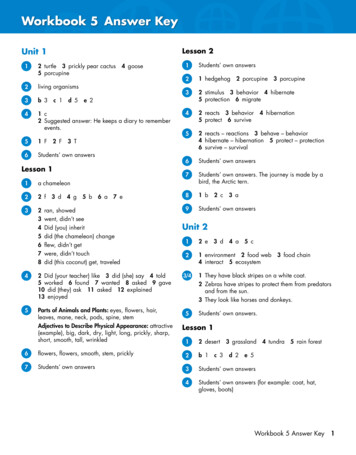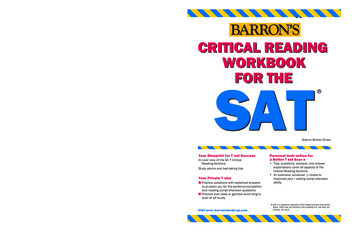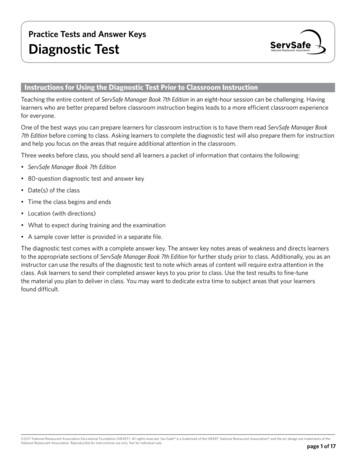
Transcription
Workbook 5 Answer KeyUnit 11Lesson 22 turtle 3 prickly pear cactus 4 goose5 porcupine2living organisms3b 341 c2 Suggested answer: He keeps a diary to rememberevents.51 F6Students’ own answersc 12 Fd 5 e 23 TLesson 11a chameleon22 f323456783 d4 g5 b6 a7 eran, showedwent, didn’t seeDid (you) inheritdid (the chameleon) changeflew, didn’t getwere, didn’t touchdid (this coconut) get, traveled42 Did (your teacher) like 3 did (she) say 4 told5 worked 6 found 7 wanted 8 asked 9 gave10 did (they) ask 11 asked 12 explained13 enjoyed5Parts of Animals and Plants: eyes, flowers, hair,leaves, mane, neck, pods, spine, stemAdjectives to Describe Physical Appearance: attractive(example), big, dark, dry, light, long, prickly, sharp,short, smooth, tall, wrinkled1Students’ own answers21 hedgehog32 stimulus 3 behavior 4 hibernate5 protection 6 migrate42 reacts 3 behavior5 protect 6 survive52 reacts – reactions 3 behave – behavior4 hibernate – hibernation 5 protect – protection6 survive – survival6Students’ own answers7Students’ own answers. The journey is made by abird, the Arctic tern.81 b9Students’ own answers2 c2 porcupine3 porcupine4 hibernation3 aUnit 212 e21 environment 2 food web4 interact 5 ecosystem3/453 d4 a5 c3 food chain1 They have black stripes on a white coat.2 Zebras have stripes to protect them from predatorsand from the sun.3 They look like horses and donkeys.Students’ own answers.Lesson 112 desert3 grassland4 tundra5 rain forest6flowers, flowers, smooth, stem, prickly2b 17Students’ own answers3Students’ own answers4Students’ own answers (for example: coat, hat,gloves, boots)c 3d 2 e 5Workbook 5 Answer Key1
Workbook 5 Answer Key561234Sally is visiting the tundra.The ground was frozen.The caribous were eating grass and mushrooms.They dig through the snow to find food.Students’ own answersUnit 312 rice 3 spinach 4 fish 5 beans6 milk 7 meat 8 orange2Answers and suggested answers:Lesson 212 energy pyramid 3 resources5 food web 6 food chain4 energy2Decomposers: bacteria, fungi, slugCarnivores: alligator (example), lion, mountain lion,owlHerbivores: deer, grasshopper, rabbitArrows from Herbivores to Carnivores toDecomposers32 raccoon 3 deer 4 owl5 squirrel 6 mountain lion4a 552 There are more trees in the rain forest than inthe desert.3 In a food pyramid, less energy flows to consumersthan producers have.4 There’s less energy in the higher levels of anenergy pyramid.5 The mountain lion eats more than one type of prey.6 When a population grows, more resources areneeded.b 6c 3Lesson 33 e4 lonpineapple lettuce31 c2 c41 nutrients3 a4 b5 a2 nutrition6 bVegetables7 c3 dietLesson 111 c2 a3 d4 b22 proteins 3 carbohydrates 4 starch5 Calories 6 fats 7 glucose 8 cholesterol31 Fats and Sweets 2 Milk and Meat3 Fruits and Vegetables 4 Bread and RiceFats and Candy is the smallest.Bread and Rice is the largest.4Students’ own answers5c6Students’ own answersLesson 211 d21 change 2 environment5 competition3Suggested answers:2 Some changes help living, and others harm them.3 Some soils are sandy, and other soils are fertile.4 Some animals survive better than others.5 Some people harm the environment, and othersprotect it.42 aDairy5 b3 positive4 negative12 adjective 3 adjective 4 adjective5 noun 6 noun 7 adjective2123431 C41 undernourishedovernourished (example), dairymalnutrition, deficientundernourished, grainsobesity2 B3 A2 normal3 overnourishedStudents’ own answersWorkbook 5 Answer Key2
Workbook 5 Answer Key5Mr. Bridge is quite healthy.61 should7Students’ own answersLesson 22 should 3 shouldn’t4 shouldn’tReview 1–3Across: 2 goose 3 tundra 6 protein 7 starch8 desert 9 fiberDown: 1 glucose 2 grains 4 moth 5 turtle33%41 in the oceans1 F5Students’ own answers4 T5 a5 T6 c7 a2 freshwater lake 3 salt water 4 ocean5 ice caps 6 glaciers 7 groundwater8 drinking water23 T4 c21 b2 F3 bFresh Water: glaciers, groundwater, ice caps, lakes,ponds, rivers, snowDrinking Water: groundwater, lakes (example), riversSalt Water: oceans, lakes132 c18 c6 F2 in glaciers and ice caps3 31%Lesson 3Unit 412 c – flood6 a – river3 b – ash 4 f – landslide22 V3 F3A 2B 141 B2 B5Students’ own answers4 V5 L5 d – lava6 F3 A12 precipitation 3 evaporation4 recycled 5 water cycle 6 water vapor7 storage21 b3/4both5Lesson 112 earthquake 3 epicenter6 volcano 7 drought22 F3geysers (and volcanoes)42 DS5Students’ own answers3 F3 F4 T5 F4 F6 T4 fault5 focus123452 a3 c4 bwhen the water started to boil / reached 100 Cthe evaporationliquidthe vaporbUnit 511 d2 c22 solar system 3 space5 phases of the moon3Suggested answer: space, the life of an astronaut,star patterns, the moon42 F3 T3 e4 F4 a5 b4 star patterns5 TWorkbook 5 Answer Key3
Workbook 5 Answer KeyLesson 1Lesson 31a telescope11 second21 Galileo’s telescope made objects eight times biggerin size.2 People didn’t like Copernicus’s theory because theybelieved that Earth was the center of the universe.3 Galileo wrote about space until the last day of hislife.22 solar 3 outer 4 inner7 gravity 8 ellipse3Students’ own answers4Which planet would you like to visit, and why?51 Neptune 2 Neptune’s moons3 the Martian/alien 4 Earth6Students’ own answers31 star 2 cause5 constellation3 astronomer 4 effect4farmers and sailors51 the ancient Greeks2 When they could see all of the constellationof Orion3 Because it is right above the North Pole61 to move2 can’t7Students’ own answersLesson 211 solar eclipse2False sentence: When the sun passes between themoon and Earth, there’s a solar eclipse.3b4b 351 The moon shines because it reflects sunlight.2 During a total solar eclipse, it becomes darkbecause the moon casts a shadow on Earth.3 There’s a full moon tonight because the moon’sbright side directly faces Earth.4 Don’t worry if you miss a lunar eclipse becausethere are several (lunar eclipses) in a year.c 5d 22 lunar eclipsee 43 first4 third5 asteroids6 cometsUnit 611 measure21 e3Students’ own answers41 Water5Suggested answers:1 Both wood and popcorn change state whenheated, but can’t change back.2 Both water and ice cream can turn from a solid intoa liquid and back into a solid again.6Students’ own answers3 orbitF 62 fourth2 states2 c3 a3 separate4 b4 matter5 d2 Ice Cream3 Popcorn4 WoodLesson 112 T3 F2Students’ own answers31 compare4Students’ own answers51 d61 What do you do to the butter? You melt it.2 How is the cocoa measured? It’s measured inteaspoons.2 a4 T5 T6 F2 liquid3 c3 volume4 bWorkbook 5 Answer Key4
Workbook 5 Answer KeyReview 4–6Lesson 212 solution 3 solubility 4 filtration 5 solute6 condensation 7 evaporation 8 solvent22 solute 3 mixture 4 solubility 5 solvent6 condensation 7 solution 8 evaporation3Students’ own answers4/56oil salt sand sugar 11 a21 eclipse6 ice31 flood 2 astronomer5 gravity42 A magnet can separate iron from sand.3 How can you measure the volume of a liquid?4 You can turn water back into ice, but you can’tunpop popcorn.5 You can compare the mass of two objects with apan balance.1 substances 2 physical change 3 particles4 matter 5 chemical change22 crushing 3 folding6 decaying32 physical 3 physical 4 chemical6 chemical44 burning 5 melting5 physicalSuggested answers:1 broken pencil 2 crumpled newspaper3 origami / folded paper 4 burning wood5 ice melting 6 brown banana51 Physical6If the temperature is below zero, these puddlesfreeze.If it isn’t wet, it doesn’t stick, and it falls apart.If you leave a banana on a plate for a few days, itstarts to turn brown.If it’s out in the open and rain falls on it, the metalparts turn brown and orange.72 Chemical3 b4 c2 land5 b3 cycle6 a7 a4 water3 comet8 b5 system4 asteroidN AJTVKTSXDEGSYA NTG DRLZTHCHJBEJIN N C G DJZCLQ U N ULesson 312 cALRELAUPO N DKRMIVIRZQ AEUAPADYLRVXFHSNSM MIXTUREHZEZM O CISHR1 lava 2 ash 3 river 4 pond6 eclipse 7 liquid 8 mixture5 droughtUnit 71a 3b 1c 221 thermal energy31 sound4Students’ own answers5Students’ own answers2 sound energy2 thermal3 light energy3 lightStudents’ own answersWorkbook 5 Answer Key5
Workbook 5 Answer KeyUnit 8Lesson 112 d3 h4 b5 c6 f 7 a22 frequency 3 amplitude 4 volume 5 vibrations6 sound waves 7 pitch 8 wavelength32 echo 3 echolocation 4 frequency 5 distances6 temperature 7 greater 8 vibrations42 outward6 during3 through4 toward8 g5 betweenLesson 211 prism 2 rainbow 3 reflection5 refraction21 b3a41 F51 couldn’t2 e3 a 4 c2 F3 F2 could4 absorption2 b2Students’ own answers3From left to right: 3, 1, 4, 23 couldn’t 4 could3 f4 g5 a6 e7 dLesson 111 electric force 2 static electricity4 lightning 5 electric charge2Included in the text: where and when he was born,his inventions, his family, who he worked for31234541 move toward4 reach for5 dLesson 33 atomsSerbiaa yearremote control / the first electric motor / radioit can travel a long way and it’s saferHe didn’t believe that atoms are made of smallerparticles.2 sticks, picks up3 builds upLesson 211 friction 2 radiation4 convection22 warm 3 touch 4 gases/liquids5 liquids/gases 6 waves 7 surfaces3Students’ own answers4Suggested answers:1 Yes, I have. Heat was transferred from the blanketto my body by conduction.2 Yes, I have. Heat was transferred from the sun tomy body by radiation.3 Yes, I have. The water got warm because heat wastransferred from the hot water to the cold water byconvection. The hot water got cooler and the coldwater got warmer.4 Yes, I have. The wheels slipped because therewasn't much friction between the wheels andthe grass.513 conduction8 absorb12 conductor 3 battery 4 electric current5 series circuit 6 parallel circuit24 doesn’t move – moves5 flows – doesn’t flow6 there’s one path – there are two or more paths3Batteries—Don’t forget to recycle them!41 shouldn’t2 can3 half4 15%5 quarterStudents’ own questions and answersWorkbook 5 Answer Key6
Workbook 5 Answer KeyLesson 3Lesson 211 b2 c21 phantom energy 2 power source4 filament 5 device3c41 e2 c3 e3 b4 a4 a5 d3 resistor5 d1 average speed 2 speed4 direction 5 velocity2a 43Students’ own answers4The Formula 1 car is the fastest.5Unit 912 e3 d4 f2a 2b 1c 331 DS2 F3 T5 cb 2c 1 d 53 acceleratione 3Formula 1 carCheetah6 aUsain Bolt4 FSailfish5 T0Lesson 11150100150200250300350400km/hrTop Speed2 reference point 3 balanced forces4 relative motion 5 mass 6 motion8 weight2 a 3 b4 c7 force21 b31 Prediction 2 Preparing for the Experiment3 Doing the Experiment 4 Conclusions41 The student thought that heavier objects would fallfaster.2 They dropped the balls from the window.3 No, it wasn’t. (Galileo’s theory is right.)51 c2 a6Students’ own answers5 a6Students’ own answers7Students’ own answers81 64 2 169Students’ own answersReview 7–911 b2 c3 c4 a5 b6 b7 a21 socket 2 lightning 3 balanced forces4 filament 5 battery 6 sound waves31 direction 2 vibrations 3 absorption4 reflection 5 resistor 6 insulator7 acceleration 8 conductionWorkbook 5 Answer Key7
Workbook 5 Answer KeyReading SkillsWriting SkillsUnit 1bUnit 11 worked 2 noticed 3 were 4 looked6 differed 7 didn’t know 8 becameUnit 2aUnit 3bUnit 4a volcanic eruptionUnit 5cUnit 6bUnit 7pleased, interested, wellbUnit 8Students’ own answersUnit 9You use the relative motion of the objects to decide what ismoving and what is not moving.5 hadUnit 2Students’ own answersUnit 3Students’ own answersUnit 4Students’ own answersUnit 51 Each time the moon completes a turn on its axis, it alsotravels once around Earth.2 The sun’s gravity pulls planets toward it.Unit 6Students’ own answersUnit 7Students’ own answersUnit 81 pick up2 build upUnit 9Students’ own answersWorkbook 5 Answer Key8
Workbook Workbook 5 Answer Key 2 5 Answer Key 5 1 Sally is visiting the tundra. 2 The ground was frozen. 3 The caribous were eating grass and mushrooms. 4 They dig through the snow to find food. 6 Students’ own answers Lesson 2 1 2 energy pyramid 3 resources 4 energy 5 food web 6 food chain 2 Decomposers:










